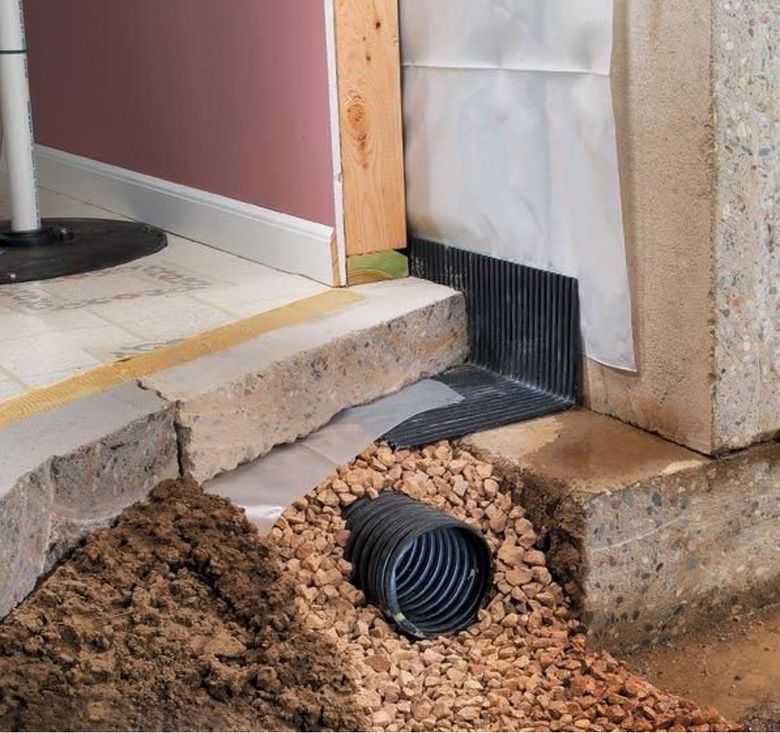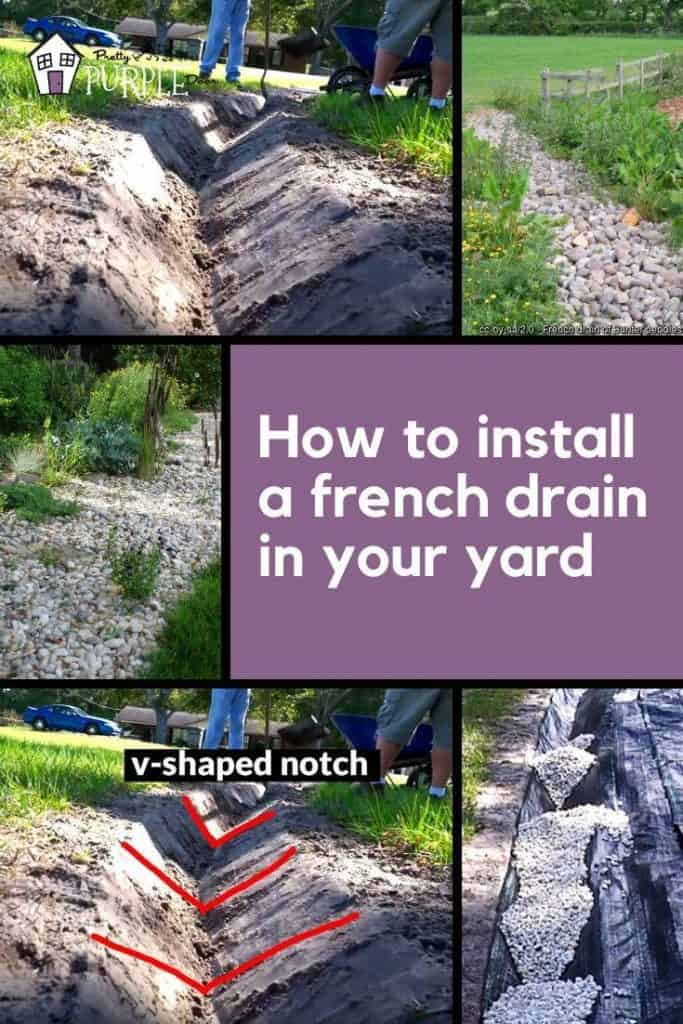How a Portland French Drain Prevents Lower Level Flooding
How a Portland French Drain Prevents Lower Level Flooding
Blog Article
The Vital Overview to Preserving Your French Drainpipe for Resilient Performance
Maintaining your French drain is vital to its performance and your property's protection. Normal checks can conserve you from pricey repair work and water damages. You'll need to know what indications to search for and just how commonly to examine your system. Plus, recognizing the cleaning process can make a significant difference. Allow's check out the crucial steps for guaranteeing your drainpipe functions well for years to find.
Recognizing the Function of a French Drain
A French drainpipe is an essential part in taking care of water around your home. It routes excess water far from your foundation, preventing flooding and damages. When heavy rain falls, the drain accumulates water via a perforated pipeline hidden in crushed rock. This system permits water to flow openly, reducing stress on your cellar walls and minimizing the risk of leaks.You might wonder exactly how it operates in technique. As water saturates the dirt, gravity draws it toward the drainpipe. The perforated pipe records this water, transporting it to a marked water drainage location or tornado sewage system. This procedure keeps your backyard dry and shields your home's architectural integrity.Understanding how a French drain functions is key to appreciating its value. By properly transporting water away, it helps preserve a secure and dry living environment. Keeping your French drainpipe in leading problem guarantees you prevent pricey repair services down the line.
Regular Assessments: What to Seek
Begin by examining for any blockages that could be blocking water circulation when you're examining your French drainpipe. Take notice of signs of surface area erosion around the drain, as this can suggest prospective issues. Routine evaluations will help keep your drainage system working properly.
Clogged Drain Assessment
Just how can you tell if your French drainpipe is obstructed? First, look for water pooling in your lawn, especially after hefty rain. That's a red flag if you notice locations where water gathers instead of draining. You need to also inspect the drain outlet; if water isn't flowing out as it should, there's likely a blockage. Pay attention for unusual gurgling noises, which can show trapped air. In addition, evaluate the drain's surface for any kind of greenery development, as origins can obstruct the system and penetrate. Lastly, if you scent moldy odors, it can indicate stationary water brought on by an obstruction. Frequently assessing these indications can assist you maintain your French drain efficiently and stop costly fixings.
Surface Area Erosion Examine

Cleaning Your French Drainpipe: Step-by-Step Overview
Cleaning your French drainpipe is essential for keeping it functioning appropriately. You'll require some certain tools and a clear process to guarantee every little thing runs efficiently. Let's go through the actions and suggestions for preserving your drainpipe efficiently.
Devices You'll Require
To deal with the job of cleansing your French drain effectively, you'll intend to gather a couple of necessary devices. Grab a sturdy pair of handwear covers to safeguard your hands from particles and sharp items. A small shovel or trowel will certainly assist you eliminate dirt or clogs around the drainpipe. For cleaning out the inside, a plumber's serpent or a high-pressure water nozzle can be incredibly useful. You'll additionally need a bucket for collecting any type of debris you take out. Finally, having a garden tube available will make it much easier to rinse out the drain and assure it's flowing efficiently. With these tools all set, you'll be established for a comprehensive cleansing session!
Cleansing Process Steps
Beginning by assessing the location around your French drainpipe for any type of noticeable debris or obstructions. Remove fallen leaves, branches, or dirt that may obstruct water flow. Next off, inspect the inlet and outlet locations; clear any obstructions to guarantee appropriate drain. Use a garden hose to flush the drain, directing water right into the inlet. This assists dislodge any gathered sludge or debris. Take into consideration making use of a plumbing technician's snake to damage them up if you see relentless blockages. After cleaning, evaluate the crushed rock around the drainpipe; replenish it if it's gotten rid of. Validate the drain covers are intact and firmly in area to prevent particles from getting in. Regular cleansing maintains your French drainpipe working successfully.
Upkeep Frequency Tips
While normal upkeep is vital for your French drainpipe's durability, knowing exactly how typically to keep it can make all the difference. Preferably, you must check your French drainpipe at least two times a year, ideally in spring and autumn. After hefty rains or snowmelt, check for blockages or particles. If you see any type of standing water, it's time to cleanse your drain.In locations with hefty vegetation, even more frequent maintenance-- regarding every three months-- may be needed. Furthermore, consider cleaning your French drain after significant tornados or if you observe water merging in your lawn. By remaining proactive, you'll guarantee your French drain features properly and safeguards your home from water damages. Normal checks will save you time and money in the future.
Determining Common Issues and Their Solutions
It's essential to recognize typical concerns with your French drain and implement effective solutions when you discover water pooling in your lawn or damp places in your basement. One frequent issue is obstructing, usually triggered by debris like fallen leaves or sediment. To repair this, you can make use of a pipes serpent or a high-pressure water jet to clear blockages.Another problem could be inappropriate slope. Water won't flow away from your home if your drainpipe isn't sloped correctly. You can adjust the slope by digging and repositioning the drain pipe.Lastly, look for damage or splits in the drainpipe itself. If you locate any, replacing the damaged sections is very important for peak efficiency. By dealing with these problems promptly, you'll assist assure that your French drain remains to operate effectively, safeguarding your residential or click over here now commercial property from water damages and keeping a completely dry, safe atmosphere.
Seasonal Upkeep Tips for Your French Drain
Addressing common concerns with your French drainpipe is just the initial action in assuring its long-term performance. Seasonal upkeep is vital for peak efficiency. In the spring, eliminate leaves and debris that may have gathered throughout winter months. Check for any obstructions in the electrical outlet or catch container, as water requires a clear path to stream freely.During summer, inspect your drain for any indicators of working out or changing dirt. Make certain it's still level and functioning correctly. As autumn strategies, clear out any type of fallen entrusts to stop obstructions before winter arrives.In winter season, look for freezing temperature levels. Make sure your drain isn't at risk of freezing if you live in a chilly climate. Insulating exposed pipelines can assist. Routine checks and prompt upkeep can stop costly repair services and keep your French drainpipe working efficiently year-round. Remain proactive and take pleasure in comfort recognizing your drainage system remains in good condition!
When to Contact a Professional
Knowing when to call an expert can save you time and protect against further damages to your French drain. It's a clear indicator that your drainpipe may be blocked or harmed if you notice persistent standing water in your yard. Don't ignore unusual odors, as they can suggest sewage back-up or degeneration, which needs prompt attention.If you discover that your drainpipe isn't working effectively after efforts to tidy or keep it, it's time to connect for specialist help. In addition, if you're uncertain regarding the underlying problems or do not have the needed devices, employing a professional can provide peace of mind.Finally, if your French drain is old or has actually experienced significant damage, professional analysis can figure out whether repair services or full substitute is needed. Trust the experts to guarantee your drain system functions effectively for years to find.
Tips for Avoiding Future Water Drainage Issues
To maintain your French drainpipe working effectively, frequently examining and maintaining it can make all the distinction. Start by clearing debris, leaves, and dirt from the surface and drainpipe openings. This protects against obstructions that can my review here lead to water back-up. Examine the crushed rock around the drain; if it's compressed or deteriorated, consider including fresh crushed rock to preserve suitable flow.Next, divert water away from your drainpipe by making certain gutters and downspouts are clear and routing water at least three feet far from your foundation. Routinely examine for any type of indications of damage or sagging. If you notice issues, resolve them immediately.Finally, consider installing a filter or a catch basin to trap larger particles prior to it goes into the drainpipe. By remaining proactive with these ideas, you'll lessen the risk of future water drainage issues and keep your French drain in leading form.
Frequently Asked Questions
For how long Does a French Drainpipe Typically Last?
A French drain usually lasts around 30 to 40 years, depending upon the products utilized and upkeep (Portland French Drain). If you maintain up with regular checks, you can prolong its life expectancy also further
Can I Set Up a French Drain Myself?
Yes, you can set up a French drainpipe yourself if you've got the right tools and expertise. Just ensure to prepare carefully, follow neighborhood guidelines, and warranty correct drain to avoid future concerns.
What Products Are Made Use Of in a French Drainpipe?
You'll need perforated pipeline, gravel, landscape textile, and a solid drain pipe for your French drainpipe. These materials aid redirect water successfully, preventing flooding and maintaining your residential property completely dry and safe from water damages.

Is a License Required to Install a French Drainpipe?
You'll likely need a permit to install a French drainpipe, depending upon neighborhood policies. Consult your town to assure you follow any essential standards and stay clear of potential concerns during installation.
What Are the Costs Connected With French Drain Maintenance?
Maintaining a French drain typically costs in between $100 and $500 every year. You'll need to think about costs for cleansing, repair work, and evaluations. Routine upkeep helps protect against larger costs and guarantees your system functions appropriately for years - Portland French Drain. When you're evaluating your French drain, begin by examining for any type of clogs that could be blocking water flow. By staying positive, you'll assure your French drainpipe functions successfully and secures your home from water damage. When you discover water merging in your yard or damp places you could try these out in your basement, it's crucial to determine typical concerns with your French drainpipe and implement reliable remedies. You can readjust the slope by digging and rearranging the drain pipe.Lastly, check for damage or fractures in the drainpipe itself. Check the crushed rock around the drain; if it's compressed or deteriorated, think about including fresh crushed rock to preserve perfect flow.Next, divert water away from your drainpipe by making certain seamless gutters and downspouts are clear and guiding water at least three feet away from your structure
Report this page